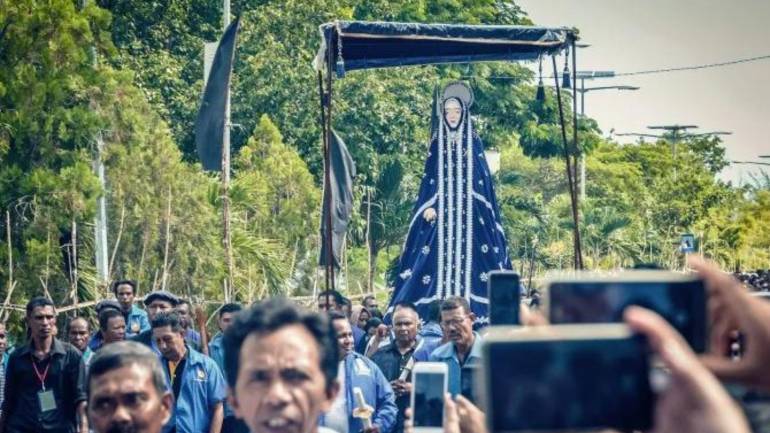Marian pilgrimage sites in Indonesia

Indonesia is home to the world's largest population of Muslims, much bigger than the combined populations of Saudi Arabia, Iraq, and Iran.
Indonesia is also not an Islamic state, but a secular democratic one. It has no state religion, unlike in Islamic states. As a result, Catholics can freely and publicly practice religious traditions.
Flores Marian procession
Flores, an island in the eastern half of Indonesia, is the only part of this Muslim country where Catholics comprise the population.
The Catholic faith arrived on the island when the Portuguese landed here in search of spices in the 16th century.
In 1510, a young boy from Flores named Resiona was hunting for snails near the shore in Larantuka, a town at the eastern tip of Flores, when a lady suddenly appeared to him.
The boy inquired for her name. But instead of verbally answering the question, the lady wrote in the sand "Akulah Reinha Rosari" [I am the Queen of the Rosary].
Shortly following the apparition, the boy also found a wooden statue of Mary.
Half a century after the apparition, a new group of Portuguese missionaries set foot on the island. To their surprise, they found Mary's statue being treasured and venerated in a temple and the locals were bringing gifts to her in thanksgiving for the good harvest.
The missionaries, who were Dominicans, taught the locals everything about the statue and Mary. They also taught them to recite the rosary and to practice the Marian procession, especially during the Holy Week.
The Marian procession is a well-cherished and -preserved Catholic observance on Flores Island since its introduction by the Portuguese pioneers in the 16th century.
The Catholics on Flores Island represent 70 percent of its population.
Flores Island is renowned for its striking natural attractions, including Kelimutu, a volcano famed for its three crater lakes that change colors.
The lakes are sometimes blue, green, and black; other times, they turn white, red, and blue.
Spring water in a cave
Java is the world's most populous island and home to half of Indonesia's population - - also home to more than a hundred volcanoes and the Indonesian capital of Jakarta.
Catholics from different parts of Indonesia retrace this place for the cave inside a religious site with a massive statue of Mary. The Catholics believe that visiting and praying at the site would grant their petitions for good health.
The Javanese built Gua Maria Sendangsono [the Cave of Holy Mary] after the founding of Catholicism on the island by Fr. Frans van Lith, a Dutch Jesuit missionary in the 1900s.
The construction of Gua Maria Sendangsono was completed in 1929 - - the same year Leon Trotsky, a Russian revolutionary and critic of Stalin, was expelled from the Soviet Union to Turkey.
The water flowing from spring inside the cave is believed to cure illnesses. People who have health conditions, or have loved ones suffering from diseases travel to this Marian site to seek healing and good health.
Java is known for rice surpluses and rice exports. The Java rice, a Filipino fried and yellow rice, is named after it.
Marian shrine
Home to Lake Toba: the largest volcanic crater lake in the world, Sumatra is also frequented by tourists and pilgrims alike for its Graha Maria Annai Velangkanni [dedicated to Our Lady of Good Health].
This Catholic church has a seven-story tower, which has three domes, symbolizing heaven. Located in Medan, North Sumatra.
The church's remarkable Indo-Mughal architecture can be mistaken for a Hindu or Buddhist temple.
The Catholic church has no overt Catholic symbols, welcoming people of all racial and religious backgrounds as a result.
This Marian shrine was opened in 2005. Its ground floor serves as a community hall. The first floor is the worship area.
Mosque-like arches were designed for the ground floor's entrance. The open space in the hall looks like a musallah (a prayer hall in mosques). The hall has no door, a gesture that everyone is welcome regardless of faith, culture, or race.
Lamps illuminate the ramps. The lamp reminds the faithful to walk in the light on life's journey.
Forty lamps illuminate the ramps. Each lamp represents each of the 40 days of Christ's fasting in the wilderness.
The ramps were embedded with crosses. Each cross reminds the faithful that life's journey is full of challenges.








